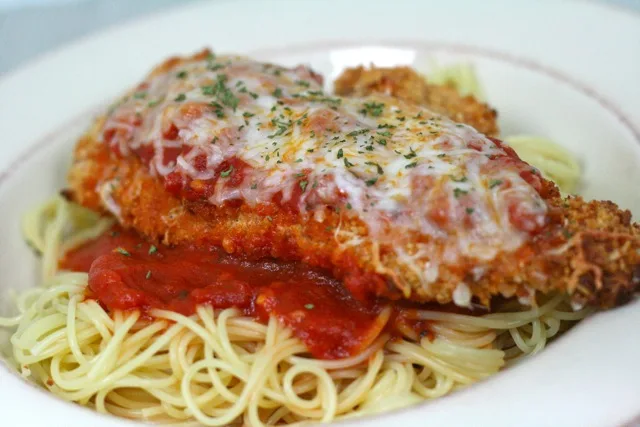Introduction
Chicken Parmesan! This iconic Italian-American dish, also lovingly called Chicken Parmigiana, beckons with its harmonious symphony of crispy breaded chicken, tangy tomato sauce, and molten cheese. With roots traced back to Italy but honed to perfection in American kitchens, this dish is a true testament to the beauty of culinary evolution. Whether you’re a seasoned cook or a kitchen novice, the journey of crafting Chicken Parmesan promises a delectable reward at its conclusion. Join us as we delve deep into the world of this beloved classic, guaranteed to impress at any dinner table.
Table of Contents
Chicken Parmesan’s Rich History
Origins and Evolution

Chicken Parmesan, also known as Chicken Parmigiana, is a dish with deep roots in Italy. The name “parmigiana” refers to dishes made with Parmesan cheese, and while its exact origin is a subject of debate, many believe it originated in Parma, a city in Northern Italy. Over time, variations of this dish emerged, with each region adding its unique touch.
Migrating to America: The Transformation
As Italians migrated to America in the 19th and 20th centuries, they brought along their culinary treasures, including Chicken Parmigiana. In its new home, the recipe underwent changes to suit local palates. The classic American version, which sandwiches the chicken between slices of bread, gained immense popularity.
Key Ingredients for Chicken Parmigiana
Choosing the Right Chicken

The foundation of a good Chicken Parmesan lies in its meat. Opt for boneless, skinless chicken breasts. They’re tender, easy to cook, and meld beautifully with the other ingredients.
The Role of Cheese: Mozzarella vs Parmesan

While Parmesan is essential, mozzarella brings in a creamy texture. Using a combination of both cheeses provides a rich taste and gooey consistency that’s hard to resist.
Importance of Fresh Tomatoes

A fresh, tangy tomato sauce elevates the dish. Ripe tomatoes, blended with herbs, garlic, and olive oil, resulting in a sauce that’s bursting with flavour.
Mastering the Recipe
Ingredients:
For the chicken:
- 4 boneless, skinless chicken breasts
- Salt and pepper, to taste
- 1 cup all-purpose flour
- 2 large eggs
- 2 cups breadcrumbs (plain or Italian-style)
- 1/2 cup grated Parmesan cheese
- Olive oil, for frying
For assembling:
- 2 cups marinara sauce (homemade or store-bought)
- 1 1/2 cups shredded mozzarella cheese
- 1/2 cup grated Parmesan cheese
- Fresh basil leaves, for garnish (optional)
- Cooked pasta, for serving
Instructions:
- Preheat the oven to 375°F (190°C).
- Start by preparing the chicken breasts. Place each chicken breast between two sheets of plastic wrap or parchment paper and gently pound them to an even thickness, about 1/2 inch.
- Season the chicken breasts with salt and pepper on both sides.
- Set up a breading station: In one shallow dish, place the flour. In another dish, beat the eggs. In a third dish, mix the breadcrumbs and grated Parmesan cheese.
- Dredge each chicken breast in the flour, shaking off any excess. Dip it into the beaten eggs, allowing any excess to drip off. Finally, coat it with the breadcrumb mixture, pressing the breadcrumbs onto the chicken to adhere.
- In a large skillet, heat enough olive oil to cover the bottom of the pan over medium-high heat. Once the oil is hot, add the breaded chicken breasts and cook for about 3-4 minutes on each side, or until they are golden brown and cooked through. Transfer the cooked chicken to a paper towel-lined plate to absorb any excess oil.
- In a baking dish, spread a thin layer of marinara sauce. Place the cooked chicken breasts on top of the sauce.
- Spoon some more marinara sauce over each chicken breast, then sprinkle shredded mozzarella and grated Parmesan cheese on top.
- Bake the chicken in the preheated oven for about 20 minutes, or until the cheese is melted and bubbly.
- If desired, broil the chicken for an additional 2-3 minutes to achieve a golden and slightly crispy cheese topping.
- Remove from the oven and let the Chicken Parmesan rest for a few minutes before serving.
- Garnish with fresh basil leaves, if using. Serve the Chicken Parmesan over cooked pasta and with additional marinara sauce on the side.
Enjoy your homemade Chicken Parmesan!
Feel free to adjust the ingredients and quantities according to your preferences and the number of servings you need.

Wine Pairings
A glass of Chianti, with its acidic and fruity profile, complements the dish’s savoury flavours, making it a delightful choice. Other options like Merlot or Sangiovese also enhance the dining experience, ensuring every bite is a harmonious blend of taste and aroma.
Accompaniments: What Goes Best with Chicken Parmesan?
Traditionally served atop spaghetti, soaking in the rich flavours. However, to balance the dish’s richness, many choose light accompaniments such as a fresh garden salad dressed in vinaigrette or steamed vegetables. Garlic bread, with its aromatic buttery goodness, also makes a popular side, perfect for mopping up any leftover sauce, ensuring every ounce of flavour is savoured.

Caloric Breakdown
On average, a serving of Chicken Parmesan contains around 350-400 calories, mainly from proteins and fats.
Storage and Reheating
How Long Does It Last?
Storing Chicken Parmesan properly ensures it remains delicious for another meal. In the refrigerator, it can be safely kept for up to 3-4 days when placed in an airtight container. If you wish to store it for a more extended period, consider freezing it. Properly wrapped in freezer-safe bags or containers, Chicken Parmesan can last up to 2-3 months in the freezer. However, for the best flavour and texture, it’s advisable to consume the dish sooner rather than later. Always remember to label the dish with a date to keep track of its storage time.
Microwave vs. Oven: Reheating Done Right
Reheating Chicken Parmesan without compromising its taste and texture requires a bit of care. The oven is your best bet. Preheat it to 375°F (190°C). Place the Chicken Parmesan in an oven-safe dish, and if possible, add a touch of tomato sauce or a sprinkle of cheese on top to prevent it from drying out. Cover the dish with aluminum foil and bake for about 20 minutes, or until it’s heated through. Avoid using the microwave for the entire process as it can make the chicken’s breading soggy. If you’re in a hurry, you can give it a quick zap in the microwave before finishing it in the oven to restore that crispy texture.
Chicken Parmesan Across Cultures
Variations Around the World
The universal appeal of Chicken Parmesan has given rise to numerous variations across the globe. In Mexico, a spicy twist is added with the incorporation of jalapeños or chipotle in the sauce. French variations might lean towards a creamier consistency, incorporating béchamel. In Australia, the dish, often referred to simply as a “parma” or “parmy”, is a pub favourite, sometimes topped with ham or bacon. Asian iterations may introduce a touch of sweetness or soy-infused sauces, while some places in the U.S., especially in sandwiches, include a layer of ham, merging it with a Cordon Bleu style. Each region adapts the dish, infusing it with local flavours and preferences, making Chicken Parmesan a truly global culinary delight.

Conclusion
Chicken Parmesan, with its flavorful chicken, tangy tomato sauce, and melted cheese, is more than a dish – it’s an experience. Whether you’re savouring it in a cosy Italian trattoria or your own dining room, its comforting and delectable flavours are sure to win your heart.
FAQs
Is Chicken Parmesan truly Italian?
Yes, though the version we know has been Americanised.
Can I use other meats for this dish?
Yes! Veal is a popular substitute.
Is Chicken Parmigiana the same as Chicken Parmesan?
They’re essentially the same, with “Parmigiana” being the Italian term.
What’s the ideal cheese-melt ratio?
A 50-50 mix of Parmesan and mozzarella works best.
How can I make my dish less calorie-dense?
Opt for baking instead of frying the chicken.
Are there vegetarian versions of this dish?
Yes! Eggplant Parmigiana is a popular vegetarian alternative.



